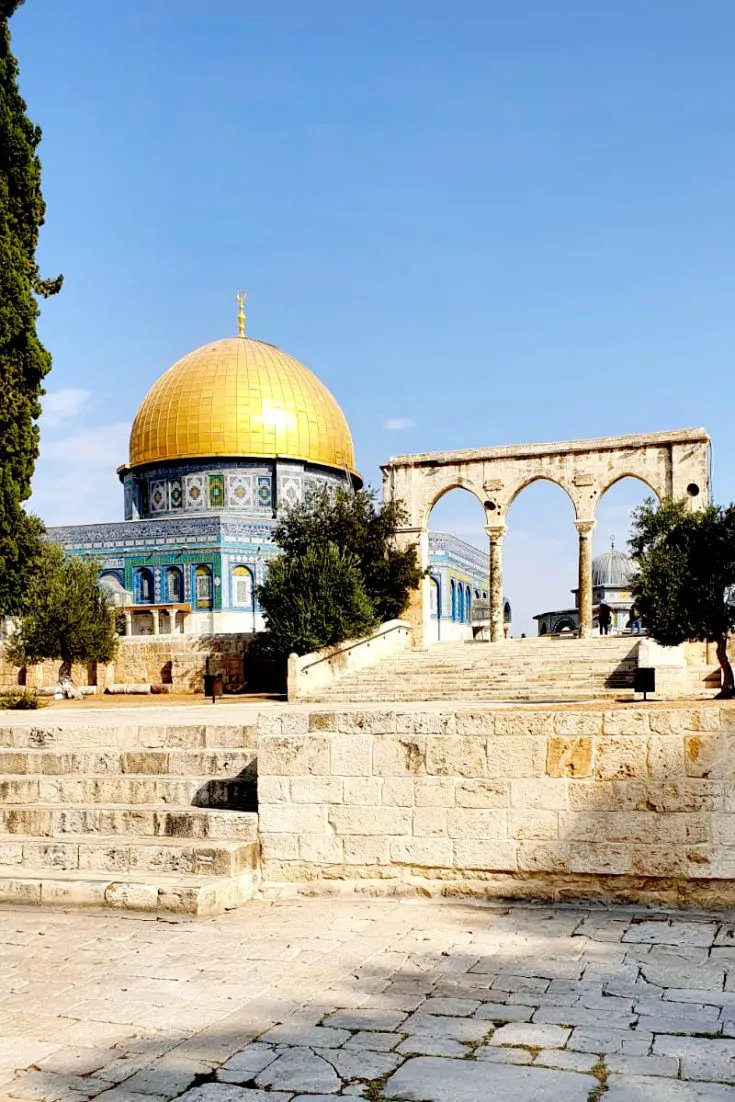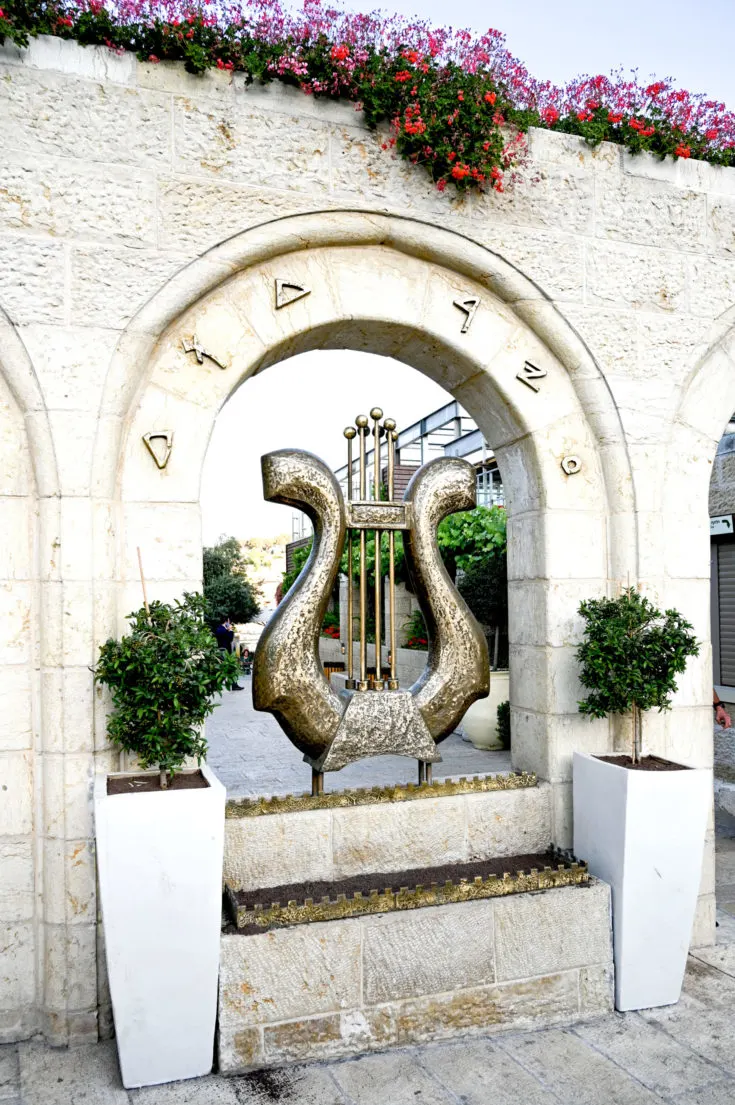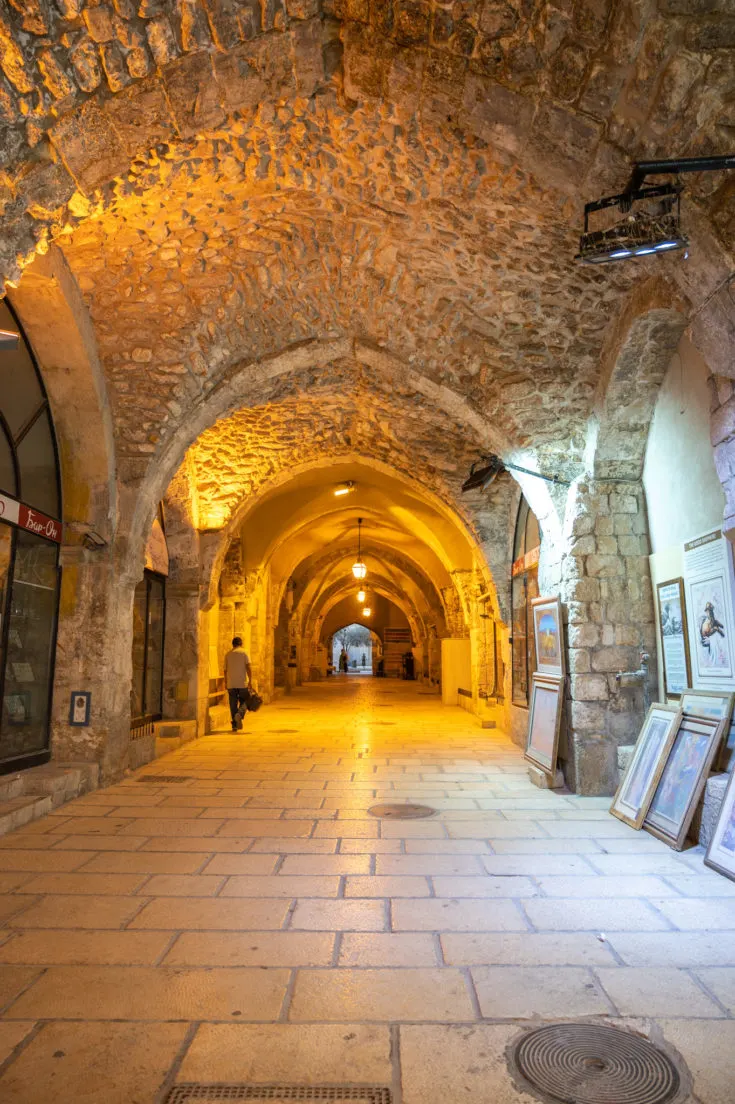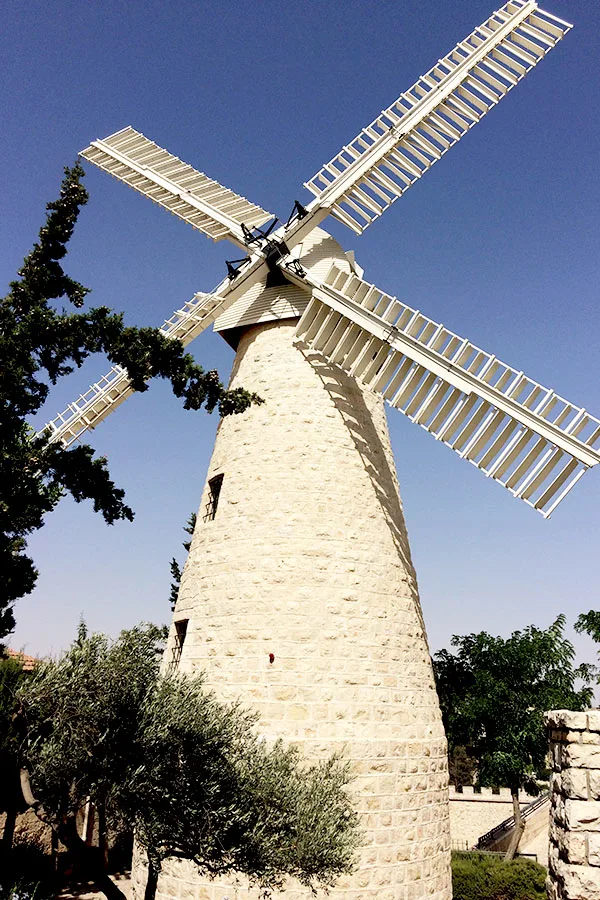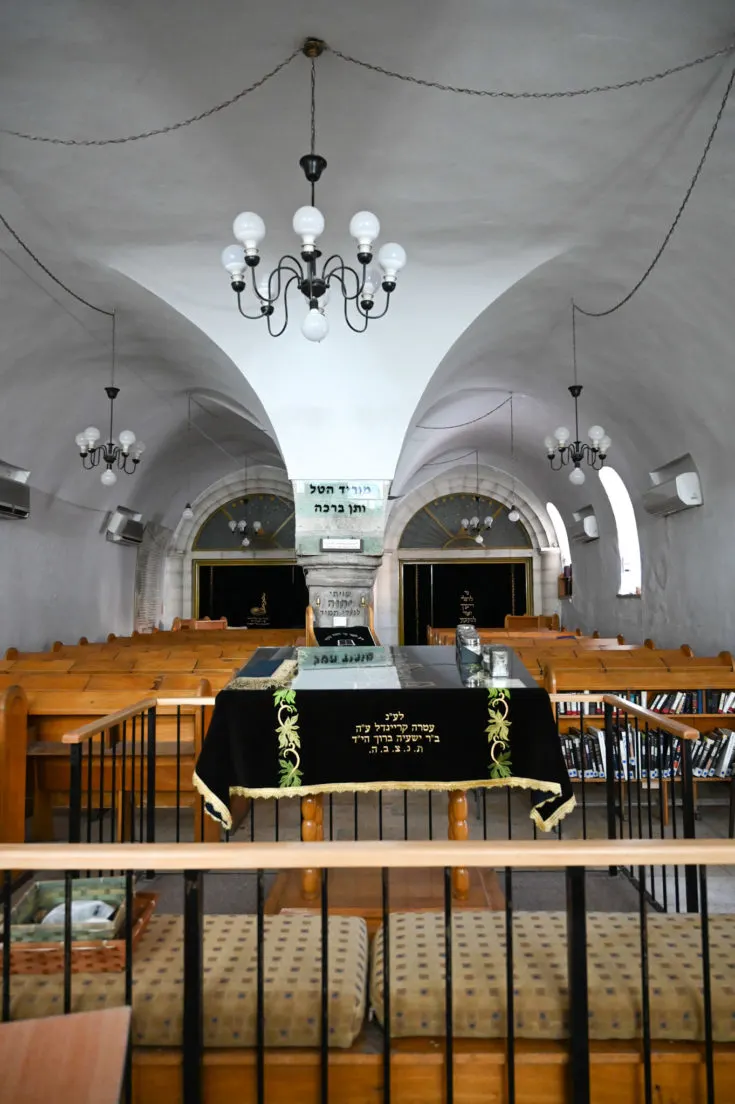If you’re looking for things to do in Jerusalem you won’t be disappointed with the variety of options.
Despite being an ancient city, Jerusalem is a lively place filled with sites, restaurants, shops, museums, and events.
Whether you love history, religion, or a night on the town, Jerusalem has things to do that you will enjoy whether you’re in the Old City or Town.
The Temple Mount
The Temple Mount refers to the elevated plaza above the Western Wall that was the site of both the First and Second Jewish Temples. It is and always has been the holiest site in the world to Jews.
in the 7th century Muslims began viewing Jerusalem and the Temple Mount as a holy site. Today it is considered the third holiest sites to Muslims, after Mecca and Madina.
At the end of that century the shrine known as the Dome of the Rock was built on the Jewish holy site shortly and Al Aqsa mosque was as well shortly there after.
Non-Muslims are permitted to visit the plaza during set days hours. However they are not allowed to enter the Dome of the Rock.
Western Wall (Kotel)
The Western Wall or the Kotel, is the last remaining wall of the Second Temple. It is revered as a holy site because it is the closest to the Temple Mount Jews are legally allowed to pray.
In addition to Jews, many Christian tourists also come pray at at the wall.
Prayers there include regular Jewish prayers that are said three times a day, saying Psalms, and personal heartfelt prayers.
It is also tradition to leave a note asking G-d for things. These can be anything your heart desires, big or small.
Chamber of the Holocaust
The Chamber of the Holocaust was the the world’s first Holocaust memorial and is a powerful yet little known museum by Israelis and tourists alike.
It was built as a symbolic cemetery, as a place for Holocaust survivors to cry and mourn for their families, especially if they didn’t know where their loved ones were buried.
The memorial was established in 1949, four years after the end of World War II and a year after Israel was founded, as Holocaust survivors who came as refugees to the country sought a place to grieve.
Built in a Crusader dungeon, the chamber was a place for Holocaust survivors and victims’ descendants to light memorial candles, recite the Kaddish, remember, and mourn.
Today, it is a museum and the objects, on display were donated by Holocaust survivors and victims’ families as a memorial to those who perished.
Yad Vashem
Yad Vashem is the Holocaust History Museum and Israel’s memorial to the victims of the Holocaust.
Established in Jerusalem in 1953, Yad Vashem has become the most visited site after the Western Wall.
It is dedicated to preserving the memory of the dead, honoring Jews who fought against their Nazi oppressors, and Gentiles who selflessly aided Jews in need.
The focus of this museum is remembrance, education, documentation, and research related to the Holocaust.
I think, together with the Chamber of the Holocaust, it tells a very important part of Jewish History.
Western Wall Tunnels
The Western Wall Tunnels offer a tours that follow tunnels under ground, between the houses of the Jewish Quarter and the Western Wall Plaza, and extends to the end of the wall under the Muslim Quarter.
The site contains unique archaeological findings from many periods of Jerusalem’s 3,000 years of existence.
This includes evidence of Jewish settlement and government from the First Temple, 2,700 years ago.
This guided tour will bring your through archaeological sites, give historical information and context of discoveries found there.
The Jerusalem Archaeological Park
The Jerusalem Archaeological Park and Davidson Center are located nearby the Western Wall in the Old City.
The park contains artifacts from different periods: the First and Second Temple periods, the Byzantine period, Muslim period, the ancient Crusades period, as well as others.
The most exciting findings are: the walls of the city from the First Temple period, the steps leading up to the Temple, the original street from the time of the Second Temple period, shops, ritual baths, and more.
However, you can also walk the streets and climb the stairs pilgrims to the Temple Mount did 2,000 years ago.
The Davidson Center is a museum within the archaeological park, with presentations and exhibitions related to findings from the site.
In addition, a virtual model with local guidance will take you back in time to the days of the Second Temple.
With it, you can and walk with pilgrims on the street, buy a sacrifice, immerse yourself in the mikveh, and ascend to Temple Mount.
Ramparts Walk
Ramparts Walk offers a unique view of the city of Jerusalem from atop of the Old City walls.
For centuries soldiers walking along the walls’ ramparts, patrolling between the gates and guard towers.
However, in recent years, the path has been renovated and turned into a promenade offering a unique view of Jerusalem inside and outside the walls.
The Tower of David
The Tower of David Museum of the History of Jerusalem is located in the medieval citadel known as the Tower of David.
The Museum presents Jerusalem’s story. It details the major events in its history beginning with the first evidence of a city in Jerusalem in the second millennium BCE, until the city became the capital of the State of Israel.
In addition, the Citadel itself is a fascinating archaeological site and offers a virtual reality tour.
The Herodian Quarter
The Herodian Quarter is a museum that exists under the Jewish Quarter. Here you can see ancient houses, ritual baths, and housewares which belonged to priests who worked in the Temple.
The City of David
The City of David is the most ancient part of Jerusalem and is only a short walk from the Western Wall.
It was created by King David began over 3,000 years ago.
Today, this ancient city is a national park and the most important archaeological site in Israel. It has some of the most exciting archaeological finds of the ancient world.
The main area that has been arranged for visitors is on the south side of the Old City near the Dung Gate.
Rockefeller Archaeological Museum
The Rockefeller Archaeological Museum houses antiquities unearthed in excavations conducted mainly during the time of the British Mandate.
The museum contains thousands of artifacts ranging from prehistoric times, dating back back one million years, to the Ottoman period.
The most charming part about this museum is the fact that it hasn’t changed much since opened in 1938.
It is frozen in time and looks very much the way museums were when British archaeologist excavated throughout the Middle East.
Israel Museum
The Israel Museum is Israel’s largest cultural institution and one of the world’s leading museums in art and archaeology.
The focus of the museum is on the art, Judaica and ancient artifacts of the Land of Israel and beyond.
It features the most extensive holdings of Biblical and Holy Land archaeology in the world.
The Museum houses works dating from prehistory to the present day in its Archaeology, Fine Arts, and Jewish Art wings.
Mahane Yehuda Market
Mahane Yehuda Market more often referred to as “The Shuk” is a favorite of locals and tourists alike.
The main street is lined with stands selling fruits, vegetables, and nuts with clothing and gift shops sprinkled in between.
However, if you go down the opens in the main path you'll find a whole other world with restaurants, cafe's, bakeries, jewelry shops, and so much more!
Museum of Italian Jewish Art
The Umberto Nahon Museum of Italian Jewish Art is the only museum that collects objects and documentation from all the Jewish communities in Italy.
It has a collection of unique and rare objects from one of the oldest Jewish communities.
The galleries exhibit Italian Jewish art and heritage artifacts including including tapestries, chanukkiot, furniture, silver and art work.
Among them, the second oldest Torah ark in the whole world, the oldest Parochet in the world, and remnants of a synagogue built in the 15th century.
In addition, there is a synagogue built in 1701 in the Rococo style and the beautifully painted Fresco Hall.
The First Station Jerusalem
Today, First Station – known in Hebrew as HaTachana HaRishona – was once a busy railway station filled with hustle and bustle.
Today it’s a chic lively place filled with restaurants, shops, and events locals love.
Hebrew Music Museum
The Hebrew Music Museum exhibits of rare and ancient musical instruments from different historical periods.
There are seven galleries, each with it’s own cultural musical styles decorated according to the style of the culture it represents.
Displayed are musical instruments and manuscripts from different musical culture behind Jewish Music and which have shaped Hebrew music.
Knesset
The Knesset is the Israeli parliament located in the Givat Ram neighborhood of Jerusalem.
Tour are given on Sunday and Thursday, no reservation require. Visitors are also welcome to sit in on debates.
Supreme Court of Israel
The Supreme Court of Israel is the highest court of Justice in Israel and the final court of appeals.
When sitting as an appellate court, the Supreme Court hears appeals mainly on judgments and decisions pronounced in the District Courts.
As the High Court of Justice (Bagatz) the Supreme Court hears petitions by any person (not only citizens or residents) against public bodies and governmental authorities.
Daily tours in Hebrew and in English and the first floor of the Supreme Court Library is open to the general public.
Wohl Rose Garden
The Wohl Rose Garden, or Wohl Rose Park, is one of the few rose parks of its kind in the Middle East, and has been proclaimed one of the most beautiful rose gardens in the world.
It features around 450 varieties of roses are grown there, many of them gifts from countries around the world.
Also displayed there are wild roses from the Land of Israel (the Dog Rose and Phoenician Rose), ancient varieties, and rare or endangered roses designated for conservation.
The Wohl Rose Park’s Garden of Nations is made up of sections donated by other countries. Each section has rose varieties characteristic of, or grown in, the respective country as well as trellises, sculptures and fountains.
In addition to some 15,000 rose bushes, the park has expansive lawns, there about 200 species of ornamental trees, bushes, and plants, an ornamental pond with aquatic plants and fish, a waterfall, rockeries, and sculptures.
Also, a sixth-century mosaic floor unearthed at Kibbutz Sde Nahum is on display in the park.
The main flowering period of the park’s roses is in the spring, from the end of April through mid May. The modern roses in the park continue to blossom through the summer and autumn seasons, until the start of winter.
Montefiore's Windmill
Montefiore’s Windmill was one of the first Jerusalem landmarks to be built outside the Old City walls.
It was built in 1857 by Sir Moses Montefiore where he would later build Mishkenot Sha’ananim which became first neighborhood in Jerusalem outside Old City.
Today, the windmill houses the Jerusalem Vineyard Wineries Visitor Center.
Near by in a glassed-in room is a replica Montefiore’s carriage which he used in his travels.
The Burnt House
The Burnt House, also known as Katros House, is a museum presenting an excavated house from the Second Temple period.
The house, was found under a layer of ashes and destruction, indicating that the house had been burned down. It was the first evidence found of the total destruction of the city by the Romans.
In the museum, you can walk through rooms that are virtually intact with artifacts from the time of the Second Temple.
Old Yishuv Court Museum
The Isaak Kaplan Old Yishuv Court Museum tells the story of the inhabitants of the Old Yishuv, displayed through their original belongings, objects, and tools.
It also tells of the struggles they had to face; stories of birth and marriage, happiness and sadness, and faith in God.
The museum depicts the period decor and aspects of daily life in the Jewish Quarter from the mid-19th century to the end of the Ottoman rule just after World War I.
Plugat Hakotel Museum
The Plugat HaKotel Museum tells the seldom mentioned story of the Western Wall Platoon, a group of 24 young men and women who risked their lives to keep a Jewish spark alive at the Western Wall.
Through the museum, located in the heart of the Jewish Quarter, together with other Zionist museums in Jerusalem, you can learn of historical Zionism beginning.
Museum visitors will begin the tour with the story of the shofar and will continue to stories of the heroism of the Irgun members who were brought up on the same values instilled by the platoon.
Museum of Underground Prisoners
The Museum of Underground Prisoners is located in the central prison during the British Mandate.
Alongside criminals, hundreds of underground warriors were imprisoned: Haganah, Etzel, and Lehi.
These were people who had been captured by the British on various actions, while fighting against foreign rule.
Guided museum tours explore the prison cells, an introduction to the story of the underground prisoners and the story of their struggle for the benefit of the Jewish population of the Land of Israel during the British Mandate.
The Hurva Synagogue
The Hurva synagogue was constructed in 1864 in what was known as the courtyard of the Ashkenazim.
It became the most important synagogue for Ashkenazi Jews living in the old city. However, it was destroyed by the Jordanian Legion forces during the fall of the Quarter Israel’s War of Independence.
The Hurva Synagogue was re-inaugurated 62 years after its destruction in March of 2010.
Little Western Wall (HaKotel HaKatan)
The Little Western Wall, also known as HaKotel HaKatan, is a Jewish religious site located in the Muslim Quarter,
While the famous section of the Western Wall is close to the south-west corner, it is actually 488-metre, or 1,601-feet long.
This smaller section is located more in the center of the wall, located approximately 170 meters north of the Prayer Plaza. However, the houses of the Muslim Quarter conceal most if of leaving only a small part exposed.
It is located near the Iron Gate to the Temple Mount and almost exactly faces where the Holy of Holies was giving it religious importance.
Four Sephardic Synagogues
The Four Sephardic Synagogues are interconnected and served as the center of the Old City’s Sephardic Community.
Yochanan ben-Zakai and ELiyahu Ha-Navi Synagogues were established first. Later the Kahal Zion and the Istambuli Synagogue, build by Turkish Jews.
During the war of independence, many of the Quarter’s residents sheltered here. After the Six Day War, the Four Synagogues were renovated and prayer was established.
Ramban Synagogue
The Ramban Synagogue, is the second oldest active synagogue in the Old City.
It was founded by the scholar and rabbi Nachmanides, otherwise known as Ramban, in 1267.
Jewish Quarter Defender's Memorial
Jewish Quarter Defender’s Memorial features rare images which capture the last days before the fall of the Jewish Quarter in 1948.
It also has short video where residents and fighters recall their experiences from those dramatic moments.
Thirty-nine fighters and thirty residents of the Jewish Quarter fell in the War of Independence.
Forty eight of them were buried in a mass grave where the Gal-Ed memorial monument now marks, Batei Machseh Square.
Herzl Museum
The Herzl Museum gives visitors insight into the life and activities of Theodor Herzl, the founder of the modern Zionist movement.
The museum details his life and many contributions to the Zionist cause.
It also provides a glimpse into Herzl’s analysis of the Jewish condition, a portrayal of his ambitions, vision, disappointments and achievements, and the challenge of his legacy.
The museum is split into four exhibition spaces, three of them showing different eras of Herzl’s life. From the beginning of his life in Vienna and the Dreyfus trial, through the Zionist Congresses in Basel until his early death at the age of 44.
The highlight of the tour is the fourth room where visitors are given a view of the accomplishments of the Jewish state, despite the many difficulties and hardships.
Mount Herzl
Mount Herzl is the site of Israel’s national cemetery where Israel’s fallen soldiers are put to rest.
Many of the Jewish state’s leaders are also buried here including Herzl himself.
This site of major national importance. It is where the families of the fallen file in crowds through the gates of Mount Herzl to attend the state Remembrance Day ceremony.
Begin Museum
The Begin Museum tells the life story of 6th Prime Minister of Israel Menachem Begin.
The exhibits explore Begin’s childhood in Poland, his years as the commander of the Irgun, the leader of the Opposition and finally, as Prime Minister of the State of Israel.
Using Begin’s life story one also learns the story of one of the most fascinating episodes of Israel’s history: the Zionist struggle for the establishment of the State of Israel and it’s early years.
Worldwide North Africa Jewish Heritage Center
The Worldwide North Africa Jewish Heritage Center is museum of the Mughrabi neighborhood in Jerusalem and its North African residents.
The Heritage Center is the only cultural and heritage center in Israel dedicated to North African Jewry.
The building houses exhibition halls with both permanent and temporary exhibitions, photographs and unique items of Jewish life in North Africa, particularly Morocco, Algeria and Tunisia.
There is also a research library with original manuscripts, studies and monographs.
Jerusalem Biblical Zoo
The Jerusalem Biblical Zoo is a wonderful way to spend a relaxing day in Jerusalem.
The zoo is home to 2,200 animals representing over 270 different species across 62 acres.
In addition to being a zoo, it also it a conservator of endangered species which they breed in captivity and, in some cases, reintroduce in to the wild.
Jerusalem Botanical Gardens
The Jerusalem Botanical Gardens is the largest plant collection in Israel and the Middle East, spanning 45 acres.
The Gardens has plants from around the world, and display more than 6,000 species.
Their collection features 2,700 native species in Israel, including 400 or so are in danger of extinction.
National Botanic Garden of Israel
The National Botanic Garden of Israel, also known as the Botanical Garden of the Hebrew University, is the first botanical garden in Israel.
It covers over 6 acres and houses more than 950 plant species, representing over 40% of the wild plant species of Israel, approximately 240 are considered rare or endangered.
The Garden is an natural hideaway within an urban landscape, a sanctuary for many animals and endangered plant species.
Many of the species are very rare or non-existent in the wild.
Jerusalem Forest
The Jerusalem Forest is a favorite by locals and has many playgrounds and picnic areas in it, along with a hiking trail.
It is filled with pine and cypress trees, as well as Palestine oak, terebinth, carob, olive, fig, pomegranate, and other species that used to cover the slopes of the Judean Hills.
On many of the slopes there are agricultural terraces, burial caves, wine-presses, and cisterns from ancient times.
Gazelles often run in the area and and you can hear the sounds of the the many songbirds who live in the trees.
Zedekiah’s Cave
Zedekiah’s Cave, or Solomon’s Quarries, is a vast cave that runs under the Old City of Jerusalem.
This cave is said to be where King Zedekiah the escape from the Chaldeans and where King Solomon got the Jerusalem stone to construction of the First Temple.
Herod also used it for building blocks in the renovation of the Temple and its retaining walls, while Suleiman used it to build present walls around the Old City.
It was once the largest quarry in ancient Jerusalem and runs under the Jewish and Muslim Quarters of the Old City of Jerusalem, stretching from Jeremiah’s Grotto to the walls of the Old City.
Jerusalem Bird Observatory
The Jerusalem Bird Observatory is Israel’s first urban wildlife site and attracts thousands of migrating songbirds to its pond and fruit trees.
This makes it the perfect for quality birdwatching at the bird hide.
In fact, this is one of the few traditional birdwatching areas in Jerusalem that has not been harmed by development.
At the heart of the Jerusalem Bird Observatory is the Beracha Bird Hide where visitors have a great view of the pond and surrounding fruit trees.
There are a variety of walks, lectures, workshops and trips offered in English and Hebrew throughout the year.
Gazelle Valley Park
Gazelle Valley Park is Israel’s biggest urban nature reserve and also the best place to watch endangered mountain gazelles in their natural habitat.
The valley was once a home to a herd of over 30 wild gazelles until 1993 their passage to the mountains surrounding Jerusalem was blocked by a new highway.
The gazelles were trapped in the valley and the herd gradually disappeared.
By the time the park was finally established, there were only 3 gazelles left.
Today there are over 45 mountain gazelles are living in the park, leading a mostly natural lifestyle.
Israelite Tower
The Israelite Tower is an archaeological site that was a significant find since it testifies to the size and strength of Jerusalem during the First Temple period.
The tower is a significant find since it testifies to the size and strength of Jerusalem during the First Temple period.
It also is evidence of Jerusalem’s destruction at the hands of the Babylonians.
Ketef Hinnom
Ketef Hinnom is a little known archaeological site consisting of a series of rock-hewn burial chambers dating from the First Temple period.
This archaeological site is located behind the Begin Heritage Center Museum.
You can reach it by through an opening in the gate coming from the main road walking towards the museum.
The Broad Wall
The Broad Wall is an archaeological site that was once Jerusalem’s protective wall during the First Temple period and one of the most important discoveries uncovered in Jerusalem.
Until the discovery of the wall, many scholars believed that the capital of the kings of Judah until the destruction of the Temple was only in the limited area of the City of David.
However, the discovery of the wall in the 1970’s reveled that the city had expanded to include the hill to the west of the Temple Mount.
This proved that the Kingdom of Judea was in fact much larger and greater than previously thought.
Jason's Tomb
Jason’s Tomb is a Second Temple Period rock-cut tomb dating to the the Hasmonean dynasty.
Some theories Jason was naval commander due to charcoal drawing of two warships discovered in the tomb.
Others believe he is the the High Priest Jason who wrote the second book of Maccabees because of the grandeur of the tomb when it was built.
Agnon House
The Agnon House in Jerusalem is a National Heritage Site, dedicated to the work of the writer S.Y. Agnon.
Agnon was Israel’s first Nobel laureate and remains the only Hebrew author to receive the prize in literature. He is also arguably the most famed writer in Israel.
Agnon and his wife Esther built this house in 1931, and he lived here until his death in 1970.
The house is now a literary museum and a venue for tours, lectures, performances, workshops, and of course and literary events.
HOLY TEMPLE MUSEUM
The Temple Institute is recreates items that were a necessary part of worship in the Jewish Temple.
These items are on display at the Holy Temple Museum, including High Priests garb and 60 sacred vessels created in accordance with biblical requirements.
Also on display is a gold and marble model of the second temple.
AISH HATORAH CENTER
Aish Center overlooks the Western Wall from across the Plaza. They host thousands of visitors annually to free religious lectures given daily, as well as their Discovery Seminar.
The Center is also home to a 1.2-ton model of the Holy Temple which sits on the rooftop terrace overlooking the site where the real Temple once stood.
The model is the largest of its kind, constructed at a scale of 1:60. It also incorporate authentic materials like gold, silver, wood, and Jerusalem stone.
In addition, it features a system that raises the sanctuary section of the Temple. This offers an internal view of key elements such as the Holy of Holies, the Menorah and the Ark of the Covenant
